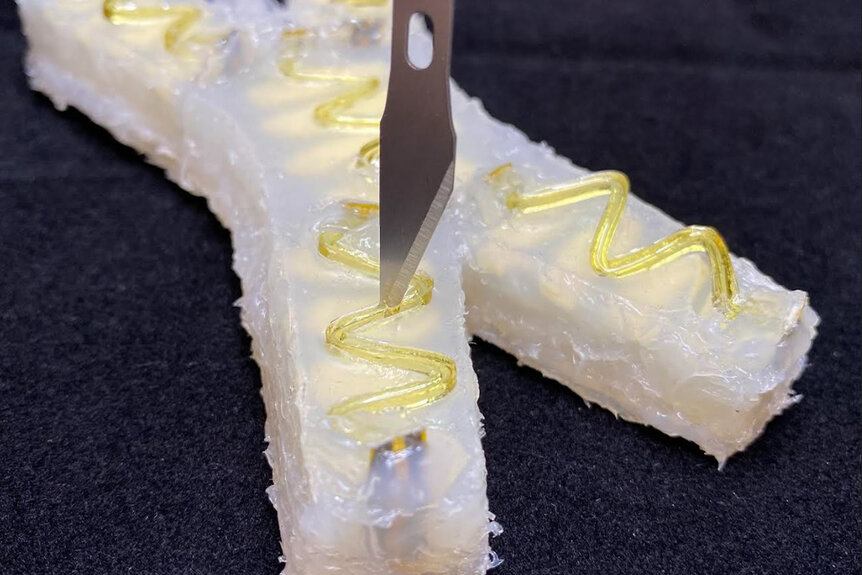Create a free profile to get unlimited access to exclusive videos, sweepstakes, and more!
Fortunately it ain't M3GAN, but this robot knows when it gets hurt and how to heal itself
We're going to save a fortune on robot healthcare.

Universal’s upcoming science fiction horror flick M3GAN takes the tried and true killer doll trope to its futuristic endpoint. It stands on the shoulders of horror greats like Chucky (now streaming on Peacock!), but with all the bells and whistles future science has to offer. It begins with Gemma, a toymaker and inventor who has dreamed her whole life of a perfect toy, one which can protect a kid from ever feeling lonely or sad. That toy is the Model 3 Generative Android, M3GAN for short, and she’s the new best friend of Gemma’s niece Cady.
Things start peacefully enough, as they always do... until they don’t. When Gemma tries to turn M3GAN off and a neighborhood bully threatens Cady, M3GAN breaks free of her programming and fulfills her objective to protect her friend, with extreme prejudice. It’s billed as a horror, and coming from producers James Wan and Jason Blum it most certainly is, but it also represents a breakthrough in robotics technology. M3GAN is only able to go on a killing spree because she is flexible, and that’s something we sorely need in our real world robots.
We’ve been sending our own trusty robots to distant locales for decades now, and every time it’s like pushing a baby bird out of the nest. We do what we can to anticipate challenges and engineer our machines to withstand the harsh environments of the solar system and beyond, but entropy eventually wins and even the very best robots succumb to nature’s endless progression toward disorder. Here on Earth, living organisms encounter many of those same forces. Exposure to radiation and hard contact with the environment can leave us bleeding or otherwise injured, but we have a trick.
Billions of years of evolution have conspired to grant us the ability to recognize when we’re injured and heal our wounds. When we’re hurt, our bodies immediately identify the problem and get to work fixing it. Our nerves sound the alarm that the walls have been breached and various processes kick into gear to stem the bleeding and repair the damage. You may be left with a scar, but you’ll be otherwise whole. Our robots, sadly, don’t have the same abilities. When they get an injury, it’s for keeps unless a human comes along to make repairs.
All of that might be about to change thanks to new research from the Organic Robots Lab, led by Robert Shepherd, at Cornell. There, researchers developed a new material capable of detecting damage and initiating self-repair. They used that material to build a small quadruped robot which recovered from stab wounds in a matter of minutes. The work was published in the journal Science Advances.
“For this project, I synthesized material that can self-heal at room temperature with no human interaction and coupled this autonomous material with light a light-sensing mechanism,” Hedan Bai, lead author of the new report, told SYFY WIRE.
The material is similar to human flesh in toughness and has some of the same weaknesses. It’s better at healing some types of injuries than others. Simple injuries like cuts or punctures are well within its reparative wheelhouse, but burns or chemical exposure can pose a problem. That’s because it interferes with the material’s inherent molecular characteristics.
“The reason it can heal cuts or punctures very well is because the cut surface has reactive polymeric end groups that can rearrange to link again on a molecular level. If you think about damage that could invalidate this requirement, such as dirt or anything that covers the end groups, that would prevent them from touching each other. If you invalidate that, they can’t heal,” Bai said.
Just like when we’re injured, rest is an important part of the healing process for soft robots too. We rest because we’re hurt and our bodies demand it, but in order for a robot to get the rest it needs to heal, it needs a way to know when it’s injured. To that end, researchers integrated optical sensors into the material and the activity of those sensors can tell the robot when it has taken damage. That’s because the optical signal in a damaged sensor drops to zero and that’s information the system can use.
“We realized if we attached them to actuators and then damage them, the sensor will detect where the damage is happening and send feedback to tell the robot it is damaged and needs time to rest for the self-healing molecular chemistry to take effect,” Bai said.
The team’s experimental robot was programmed to sit still and rest for between one and three minutes, after which the healing was completed, and it could return to work. What’s more, because the healing ability is built into the molecular structure of the material, you can repeat this process as many times as you want, and the robot will keep healing as long as the molecular end groups aren’t interfered with.
According to researchers, their material is diverse and could be used not just as a protective covering for our machines but also to construct their core components. The potential end result is a new class of machines capable of repairing damage both complex and cosmetic without our ever being involved.
“Right now, we’re only using it for sensors but there’s no real hinderance to turning the material into a whole robot. Actuators, sensors, everything, all made of this material. At that point, you have a whole body robot that can heal any of its components without external stimuli,” Bai said.
Self-healing soft robotics is an exciting field, but this technology isn’t limited to robots. Bai also mentioned possible applications for skydivers and astronauts. “They could be used in space suits for extravehicular activities or fabric for supersonic parachutes. Those systems are soft but also, if damaged, they lead to serious consequences. It would be nice to have self-healable sensors to heal that damage.” Bai said.
We couldn’t agree more.
Looking for some killer doll fun? The first season of Chucky is now streaming on Peacock.



























